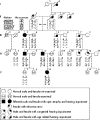Autosomal dominant optic atrophy associated with hearing impairment and impaired glucose regulation caused by a missense mutation in the WFS1 gene
- PMID: 16648378
- PMCID: PMC2649014
- DOI: 10.1136/jmg.2005.034892
Autosomal dominant optic atrophy associated with hearing impairment and impaired glucose regulation caused by a missense mutation in the WFS1 gene
Abstract
Autosomal dominant optic atrophy (ADOA) is genetically heterogeneous, with OPA1 on 3q28 being the most prevalently mutated gene. Additional loci are OPA3, OPA4, and OPA5, located at 19q13.2, 18q12.2, and 22q12.1-q13.1, respectively. Mutations in the WFS1 gene, at 4p16.3, are associated with either optic atrophy (OA) as part of the autosomal recessive Wolfram syndrome or with autosomal dominant progressive low frequency sensorineural hearing loss (LFSNHL) without any ophthalmological abnormalities. Linkage and sequence mutation analyses of the ADOA candidate genes OPA1, OPA3, OPA4, and OPA5, including the genes WFS1, GJB2, and GJB6 associated with recessive inherited OA or dominant LFSNHL, were performed. We identified one novel WFS1 missense mutation E864K, c.2590G-->A in exon 8 that co-segregates with ADOA combined with hearing impairment and impaired glucose regulation. This is the first example of autosomal dominant optic atrophy and hearing loss associated with a WFS1 mutation, supporting the notion that mutations in WFS1 as well as in OPA1 may lead to ADOA combined with impaired hearing.
Conflict of interest statement
Competing interests: there are no competing interests.
Similar articles
-
Identification of p.A684V missense mutation in the WFS1 gene as a frequent cause of autosomal dominant optic atrophy and hearing impairment.Am J Med Genet A. 2011 Jun;155A(6):1298-313. doi: 10.1002/ajmg.a.33970. Epub 2011 Apr 28. Am J Med Genet A. 2011. PMID: 21538838 Free PMC article.
-
Mutations in the Wolfram syndrome 1 gene (WFS1) are a common cause of low frequency sensorineural hearing loss.Hum Mol Genet. 2001 Oct 15;10(22):2501-8. doi: 10.1093/hmg/10.22.2501. Hum Mol Genet. 2001. PMID: 11709537 Free PMC article.
-
Mutations in the WFS1 gene are a frequent cause of autosomal dominant nonsyndromic low-frequency hearing loss in Japanese.J Hum Genet. 2007;52(6):510-515. doi: 10.1007/s10038-007-0144-3. Epub 2007 May 11. J Hum Genet. 2007. PMID: 17492394
-
[Genetic basis of hereditary optic atrophies].Klin Oczna. 2007;109(10-12):470-4. Klin Oczna. 2007. PMID: 18488399 Review. Polish.
-
Mutational spectrum of the WFS1 gene in Wolfram syndrome, nonsyndromic hearing impairment, diabetes mellitus, and psychiatric disease.Hum Mutat. 2003 Oct;22(4):275-87. doi: 10.1002/humu.10258. Hum Mutat. 2003. PMID: 12955714 Review.
Cited by
-
WFS1 protein expression correlates with clinical progression of optic atrophy in patients with Wolfram syndrome.J Med Genet. 2022 Jan;59(1):65-74. doi: 10.1136/jmedgenet-2020-107257. Epub 2021 May 18. J Med Genet. 2022. PMID: 34006618 Free PMC article.
-
Developmental hypomyelination in Wolfram syndrome: new insights from neuroimaging and gene expression analyses.Orphanet J Rare Dis. 2019 Dec 3;14(1):279. doi: 10.1186/s13023-019-1260-9. Orphanet J Rare Dis. 2019. PMID: 31796109 Free PMC article. Review.
-
Targeted genomic capture and massively parallel sequencing to identify genes for hereditary hearing loss in Middle Eastern families.Genome Biol. 2011 Sep 14;12(9):R89. doi: 10.1186/gb-2011-12-9-r89. Genome Biol. 2011. PMID: 21917145 Free PMC article.
-
The Wolfram-like variant WFS1E864K destabilizes MAM and compromises autophagy and mitophagy in human and mice.Autophagy. 2024 Sep;20(9):2055-2066. doi: 10.1080/15548627.2024.2341588. Epub 2024 Apr 23. Autophagy. 2024. PMID: 38651637
-
Phenotype Prediction of Pathogenic Nonsynonymous Single Nucleotide Polymorphisms in WFS1.Sci Rep. 2015 Oct 5;5:14731. doi: 10.1038/srep14731. Sci Rep. 2015. PMID: 26435059 Free PMC article.
References
-
- Hoyt C S. Autosomal dominant optic atrophy: a spectrum of disability. Ophthalmology 198087245–251. - PubMed
-
- Votruba M, Aijaz S, Moore A T. A review of primary hereditary optic neuropathies. J Inherit Metab Dis 200326209–227. - PubMed
-
- Eiberg H, Kjer B, Kjer P, Rosenberg T. Dominant optic atrophy (OPA1) mapped to chromosome 3q region. I. Linkage analysis. Hum Mol Genet 19943977–980. - PubMed
-
- Reynier P, Amati‐Bonneau P, Verny C, Olichon A, Simard G, Guichet A, Bonnemains C, Malecaze F, Malinge M C, Pelletier J B, Calvas P, Dollfus H, Belenguer P, Malthiery Y, Lenaers G, Bonneau D. OPA3 gene mutations responsible for autosomal dominant optic atrophy and cataract. J Med Genet 200441e110 - PMC - PubMed
-
- Kerrison J B, Arnould V J, Ferraz Sallum J M, Vagefi M R, Barmada M M, Li Y, Zhu D, Maumenee I H. Genetic heterogeneity of dominant optic atrophy, Kjer type: identification of a second locus on chromosome 18q12.2–12.3. Arch Ophthalmol 1999117805–810. - PubMed
Publication types
MeSH terms
Substances
LinkOut - more resources
Full Text Sources
Medical
Molecular Biology Databases



